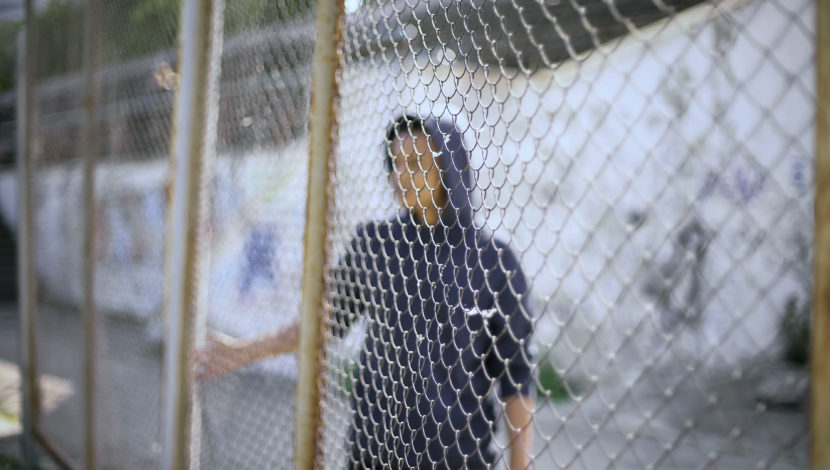The Unitarian Universalist Service Committee advances human rights through grassroots collaborations.
How to Address the Unaccompanied Minors Crisis at the Border

By on March 18, 2021
Thousands of children escaping violence, persecution, and climate destruction in their home countries are seeking refuge at the U.S. border, and the government is plainly failing to provide adequate care, or to reunite them with sponsors in a safe and expeditious way. The Office of Refugee Resettlement (ORR) is working to place kids with sponsors and relatives in the community, but their efforts are not keeping pace with the number of new children arriving in the system, most of whom are labeled “unaccompanied.”
The result is a massive backlog that traps kids in Customs and Border Protection (CBP) facilities that were never meant to house children. Recent reporting indicates that nearly 3,000 unaccompanied kids have been stranded in CBP custody in excess of the legal maximum of 72 hours, often under deplorable conditions.
What is the government doing to address this?
The Biden administration is making changes to address this crisis and to move kids through the system more quickly. While some of these are plainly steps in the right direction, others are more troubling.
First, the good: Biden’s Department of Health and Human Services recently scrapped a Trump-era information-sharing agreement with Immigration and Customs Enforcement (ICE), which exposed many family members of unaccompanied kids to arrest and deportation. By using kids as bait for deportation raids and frightening away potential sponsors, the Trump administration swelled the backlog of kids in government custody. Biden’s move to officially end this agreement, thus signaling to sponsors that they will not become targets, is therefore clearly a positive step to addressing the current crisis.
On the other hand, the administration has pursued or contemplated other steps that could make the humanitarian situation even worse. The administration’s recent decision to open an emergency “intake” facility in West Texas raises questions about whether this will turn into another form of child detention. Similarly, ORR’s decision to reopen unlicensed influx centers has reportedly sparked a bidding war among private contractors, creating a new monetary incentive to house unaccompanied kids in jail-like settings.
Finally, Buzzfeed News reports that the administration has even considered partially returning to the Trump-era practice of expelling unaccompanied kids without due process—a dreadful possibility that would return hundreds of 16- and 17-year-old asylum seekers, fleeing torture, forced gang recruitment, and other forms of persecution, to imminent risk. The administration should immediately clarify that they will not take this step.
Among the many options the Biden administration has explored, however, there is one that has been conspicuously absent from the discussion. The administration has not given a timeline for when they will restore asylum processing for adults and families at the U.S. border—even though such a step is not only the right thing to do, from a human rights perspective; it would also—as we explain below—significantly reduce the number of “unaccompanied” children forced to go through the process without adult caregivers.
Wait – the Biden administration hasn’t restored asylum?
Nope.* Despite the repeated requests and fervent hopes of asylum-seekers and advocates, the Biden administration has left in place a Trump-era policy (known as “Title 42”) of blocking and expelling the vast majority of asylum-seekers at the border.
Contrary to much of the discourse about the border crisis, moreover, this policy does not just mean the border is “closed,” or that migrants are being rapidly deported without a court hearing (that, sadly, has been happening for decades). It means something even worse: namely, that people are denied even a chance to get an exception from these rapid deportations if they fear persecution. This is what makes Title 42 such a dramatic rupture with past practice and so impossible to reconcile with the United States’ legal obligations to asylum-seekers.
For this reason, advocates have challenged the policy in court, and in November a federal judge temporarily blocked the government from applying Title 42, at least to unaccompanied kids. (He left the policy in place for adults and family units.) After the judge’s order went into effect in November (while Trump was still president), the number of children being processed as “unaccompanied” in the system began to climb, and it has continued its ascent ever since.
Since that time, Trump and Biden have both used the policy to expel asylum-seeking families and solo adults. The exemption for unaccompanied minors, however, has remained in effect—first because of the court’s order, and later (after that order was lifted), because the Biden administration chose (rightly) to keep it.
These facts suggest that many of the children currently being processed as “unaccompanied” minors did not originally intend to travel alone. To be sure, there are some who undertake the perilous journey to the U.S. border alone, and their rights too need to be upheld. But it is possible that many of these children would have opted to stay with adult family members if they could, and that some were not actually “unaccompanied” when they arrived at the border.
How Title 42 is contributing to the unaccompanied minors crisis.
We know that Biden’s continued abuse of the Title 42 policy (which he inherited from Trump) is swelling the number of “unaccompanied children” in U.S. custody and contributing to the backlog in at least four ways:
- The policy leaves families with no choice but to separate from their children, in order to ensure their safety. Because families who travel together are subject to rapid expulsion at the border, many parents and kids are trapped in dangerous conditions in Mexico or in their home countries, where they face the same violence and persecution they originally fled. Families are therefore faced with a terrible choice: either stay together in danger, or send a child alone to the U.S. border, where at least they will be processed for asylum and have a chance of gaining safety.
- Expulsions expose families to danger in Mexico that separates parents from their children. Trump-era programs to return families to Mexico exposed them to extreme danger from criminal groups that prey on migrants. In some cases, as other analysts have pointed out, parents were kidnapped or disappeared after being sent back to Mexico, leaving children “unaccompanied” for reasons totally beyond their control. While the incidents linked above happened during the Trump administration, it is likely that similar horrific events continue to take place as a result of Biden’s ongoing practice of rapidly expelling families.
- The U.S. policy of separating children from extended family members and other trusted adults leads to kids being falsely classified as “unaccompanied.” Many so-called “unaccompanied” children in U.S. custody actually arrived at the border with extended family members or other trusted adults who lack the paperwork to prove they are the child’s legal guardians. In these cases, the U.S. government has enforced a longstanding policy of separating the children from their relatives and classifying the kids as “unaccompanied.”** These separations are often traumatic for children, for obvious reasons. When they are combined with the Title 42 policy, however, the result can be even more horrific. The Associated Press recently reported on the case of a 4-year-old girl, for instance, who arrived at the border with her aunt. The U.S. government separated them, and the aunt was then expelled under the administration’s interpretation of Title 42. The 4-year-old girl was then re-classified as “unaccompanied,” even though she had actually arrived at the border with an adult caregiver.
- This policy of separating extended family members also reduces the number of available sponsors for unaccompanied kids, contributing to backlogs in the system. As a 2020 report from the humanitarian group Kids in Need of Defense observes, extended family members who travel with children to the border used to be able to serve as sponsors for the children at a later stage of the process. Even if they were separated from each other at the border, and the children were labeled “unaccompanied,” they were later able to reunite when the relatives were released from detention and able to come forward as sponsors. By expelling the adult relatives, however, the Biden administration eliminates this possibility. Title 42 expulsions are therefore reducing the pool of available sponsors and trapping more kids long-term in CBP and ORR custody.
For these reasons, the Biden team could mitigate the unaccompanied minors crisis by ending Title 42.
Eliminating the Title 42 policy would therefore go a long way toward ameliorating the unaccompanied minors crisis on the border. Allow families to pursue their asylum cases together, freely, and on U.S. soil, and far fewer children would be forced to undertake the dangerous journey to the border alone.
Making this decision should be an easy call for the Biden administration. Time and again, they have pledged to restore humanity and dignity to the way the U.S. government treats immigrants. Title 42 represents the worst and most extreme aspects of Trump’s effort to dismantle U.S. asylum protections and trap or return refugees to danger. Biden has every moral reason to do away with it.
Getting rid of this policy is not only morally justified, however; it would also make the practical task of safely processing unaccompanied children significantly more straightforward. Fewer kids would be unaccompanied in the first place, backlogs would decrease, and ORR would have far less trouble quickly placing kids expeditiously with sponsors and adult relatives.
The choice ahead for the Biden team should therefore be doubly clear: ending Title 42 is a win on all counts. It would restore human rights protections and make the administration’s job of safely and humanely managing the southern border that much easier.
___________
*At least not in full. Limited exceptions have been made for families with active cases under the former “Remain in Mexico” program. But the vast majority of asylum-seeking adults and families continue to be blocked, turned away, or expelled.
** This practice pre-dates the Trump administration’s “zero tolerance” policy, which was even more extreme (separating children even from parents and legal guardians). The U.S. government claims that ongoing separations of extended family members are necessary in order to protect children from the risk of trafficking. However, advocates have proposed better ways the government could properly screen for trafficking risk without subjecting children to traumatic separations from trusted adults.
***
About UUSC: Guided by the belief that all people have inherent worth and dignity, UUSC advances human rights globally by partnering with affected communities who are confronting injustice, mobilizing to challenge oppressive systems, and inspiring and sustaining spiritually grounded activism for justice. We invite you to join us in this journey toward realizing a better future!
Photo Credit: Motortion

